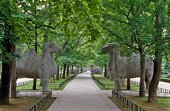Sample Nanjing Hotels Included in
Nanjing Tour Package |
|




|
|
Nanjing
City
2 Day 1 Night Tour
Nanjing Tourist Attractions:
Yangtze River Bridge, Dr. Sun Yat-sen's Mausoleum, Xuanwu
Lake, Confucius
Temple
Highlights:
* On this
tour your day will be jam packed with the best Nanjing has to
offer, from the Mausoleum of the revered Dr. Sun Yat Sen in the
Purple Mountains to the temple of China's greatest thinker,
Confucius. Lunch and dinner will be provided on your day of
touring
* Your tour includes free pick-up and transfer to either the
Nanjing airport or train station. On your tour you will have an
English-speaking guide who is a native of Nanjing, giving you an
insider's scoop into this rich and historic city
B=(Breakfast) L=(lunch) D=(dinner) DEPARTURE: Daily |
|
| |
TOUR ITINERARY |
 |
Tour
code:
GWAC-NJ-03 |
|
DAY 1 |
Arrive in Nanjing
You will fly in to the Nanjing airport, or you
can arrive by train at the Nanjing train
station. Whether you fly or arrive by train your
local English-speaking guide will meet you
wherever you arrive. For your stay in Nanjing
you'll be lodging at a 3 or 4 star hotel (for
normal tours) or a 5 star hotel (for deluxe
tours).
After allowing you to unpack and relax for a
bit, we'll start your touring of the city with a
visit to the Yangtze River Bridge. The Great
Bridge over the Yangtze River in Nanjing is not
only a striking example of post-Revolutionary
art and engineering, but the story behind it is
a source of pride for people throughout China,
and especially those in Nanjing. It is the first
modern bridge completely built by Chinese
people. After the 1949 Revolution, China worked
closely with the Soviet Union, and the Soviets
provided many technical advisors and engineers.
Unfortunately, relations between the two
countries deteriorated in the early 1960's, and
the USSR brought all of its engineers home.
Unwilling to give up, Chinese engineers managed
to overcome the challenge and create this
monumental and impressive bridge. The huge piers
of the bridge are capped with towers topped by
giant glass sculptures representing red flags
surging forward, vividly recording the
enthusiasm and patriotism of 1960's China.
Then we'll go to Nanjing's most famed landmark,
and a favorite among foreign travelers, the Mausoluem of Dr. Sun Yat Sen (also known as
Zhongshan Ling). Dr. Sun was the first president
of the Republic of China and one of the leading
organizers of the struggle to create a modern
republic in China. The impressive memorial was
built in the 1920's. Its architecture is
accentuated by its splendid natural setting on
the forested slopes of Zijin Mountain on the
outskirts of Nanjing, its buildings made of
white stone with dark blue roof tiles.
Next we will go for a leisurely walk along
Xuanwu Lake. Situated at the foot of Mt.
Zhongshan, Xuanwu Lake is a beautiful scenic
spot as well as containing one of the three most
famous lakes in Nanjing. The history of Xuanwu
can be traced back to the Pre-Qin period
(21stcentury BC-221BC). According to legend, in
the Southern Dynasty a black dragon was seen in
the lake. Chinese Daoists believed that the
black dragon appeared as the uniform of a turtle
and snake, called Xuanwu. Hence, the lake was
called Xuanwu Lake. Another legend stated that
when Sun Quan, the King of Eastern Wu Kingdom
settled down in the region, he brought water in
and made this lake. Geological studies show that
the lake was actually formed by the movements of
the geological plates when Mt. Yanshan was
formed.
In the long history of China, the lake has been
used by many dynasties as an ideal place to
train their waterborne troops. Many military
demonstrations had been held here and a lot of
battles were fought here. Therefore, the lake
was also called Military Rehearsal Lakes or Kunming Lake. At the end of the Qing Dynasty,
the lake was turned into a park. Today, the lake
is much more beautiful with its water and
colorful mountains.
We'll cap off our sightseeing with a visit to
that great sage Confucius, at his temple.
Confucius (Kong Fuzi) who taught philosophy in
China 2,500 years ago is considered the most
important figure in the shaping of ancient
Chinese civilization as well as the cultures of
the countries of Japan, Vietnam, and Korea. The
Confucius Temple is south of the city's central
district. There was a temple that was built in
the year 1034 during the Song Dynasty period on
the banks of the Qinhuai River. During the past
millennium, it was renovated, reconstructed, and
enlarged so that it became a large complex. It
was used by Confucian scholars. Next to it was
the Jiangnan Gongyuan that was the largest
examination area for people taking the imperial
examinations and the Xue Gong that was the Qing
Imperial Academy for training mandarins to
govern the vast empire.
For dinner, we will go to a local restaurant,
and you can try a meal of Jiangsu cuisine, named
after the province Nanjing is located in, and
the specialty of the region.
|
|
3 or 4 star for common; 5 star for deluxe |
|
DAY 2 |
Departure
Following breakfast in the
hotel, you'll be driven to the Nanjing airport
or train station, and you'll fly on to your next
destination, ending your stay in Nanjing. If you
would like to extend your stay in China then
please go to our China City
Tours and China
Package Tours pages to find out about more
of the great destinations in China we offer! |
|
|
|
|
|
|

